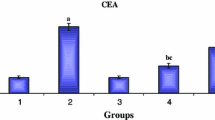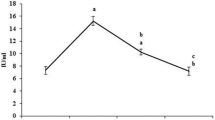Abstract
The tumor-promoting effects of oxfendazole (OX), a benzimidazole anthelmintic, were investigated using a medium-term rat hepatocarcinogenesis model. Six-week-old male F344 rats received an intraperitoneal injection of N-diethylnitrosamine (DEN) and were given a powdered diet containing 0 or 500 ppm OX for 6 weeks from 2 weeks after DEN treatment. All animals were subjected to two-thirds partial hepatectomy 1 week after OX treatment. The numbers and areas of glutathione S-transferase placental form (GST-P)-positive foci were significantly increased in the livers of rats treated with OX, with concomitantly increased cell proliferation, compared with those in the livers of the DEN alone group. Quantitative real-time RT-PCR analysis revealed that OX induced not only mRNA expression of phase I enzymes Cyp1a1, Cyp1a2, but also Nrf2-regulated phase II enzymes such as Gpx2, Nqo1, Yc2, Akr7a3 and Gstm1, presumably due to an adaptive response against OX-induced oxidative stress. Reactive oxygen species production increased in microsomes isolated from the livers of OX-treated rats. Furthermore, OX enhanced oxidative DNA damage (as assessed by 8-hydroxydeoxyguanosine; 8-OHdG) and lipid peroxidation (as assessed by thiobarbituric acid-reactive substances; TBARS). These results suggest that administration of OX at a high dose and for a long term enhances oxidative stress responses, which may contribute to its tumor-promoting potential in rats.


Similar content being viewed by others
References
Aix L, Rey-Grobellet X, Larrieu G, Lesca P, Galtier P (1994) Thiabendazole is an inducer of cytochrome P4501A1 in cultured rabbit hepatocytes. Biochem Biophys Res Commun 202:1483–1489
Baliharova V, Skalova L, Maas RF, De Vrieze G, Bull S, Fink-Gremmels J (2003) The effects of benzimidazole anthelmintics on P4501A in rat hepatocytes and HepG2 cells. Res Vet Sci 75:61–69
Brigelius-Flohe R (1999) Tissue-specific functions of individual glutathione peroxidases. Free Radic Biol Med 27:951–965
Chanas SA, Jiang Q, McMahon M, McWalter GK, McLellan LI, Elcombe CR, Henderson CJ, Wolf CR, Moffat GJ, Itoh K, Yamamoto M, Hayes JD (2002) Loss of the Nrf2 transcription factor causes a marked reduction in constitutive and inducible expression of the glutathione S-transferase Gsta1, Gsta2, Gstm1, Gstm2, Gstm3 and Gstm4 genes in the livers of male and female mice. Biochem J 365:405–416
Cheng KC, Cahill DS, Kasai H, Nishimura S, Loeb LA (1992) 8-Hydroxyguanine, an abundant form of oxidative DNA damage, causes G—T and A—C substitutions. J Biol Chem 267:166–172
Daujat M, Peryt B, Lesca P, Fourtanier G, Domergue J, Maurel P (1992) Omeprazole, an inducer of human CYP1A1 and 1A2, is not a ligand for the Ah receptor. Biochem Biophys Res Commun 188:820–825
Delatour P, Parish R (1986) Benzimidazole anthelmintics and related compounds: toxicity and evaluation of residues. In: Rico AG (ed) Drug residues in animals. Academic Press, New York, pp 175–204
Dewa Y, Nishimura J, Muguruma M, Matsumoto S, Takahashi M, Jin M, Mitsumori K (2007) Gene expression analyses of the liver in rats treated with oxfendazole. Arch Toxicol 81:647–654
Diaz D, Fabre I, Daujat M, Saint Aubert B, Bories P, Michel H, Maurel P (1990) Omeprazole is an aryl hydrocarbon-like inducer of human hepatic cytochrome P450. Gastroenterology 99:737–747
Gleizes C, Eeckhoutte C, Pineau T, Alvinerie M, Galtier P (1991) Inducing effect of oxfendazole on cytochrome P450IA2 in rabbit liver. Consequences on cytochrome P450 dependent monooxygenases. Biochem Pharmacol 41:1813–1820
Goldring CE, Rice-Evans CA, Burdon RH, Rao R, Haq I, Diplock AT (1993) Alpha-Tocopherol uptake and its influence on cell proliferation and lipid peroxidation in transformed and nontransformed baby hamster kidney cells. Arch Biochem Biophys 303:429–435
Gonzalez FJ (2005) Role of cytochromes P450 in chemical toxicity and oxidative stress: studies with CYP2E1. Mutat Res 569:101–110
Harada T, Yamaguchi S, Ohtsuka R, Takeda M, Fujisawa H, Yoshida T, Enomoto A, Chiba Y, Fukumori J, Kojima S, Tomiyama N, Saka M, Ozaki M, Maita K (2003) Mechanisms of promotion and progression of preneoplastic lesions in hepatocarcinogenesis by DDT in F344 rats. Toxicol Pathol 31:87–98
Hayes JD, Judah DJ, Neal GE (1993) Resistance to aflatoxin B1 is associated with the expression of a novel aldo-keto reductase which has catalytic activity towards a cytotoxic aldehyde-containing metabolite of the toxin. Cancer Res 53:3887–3894
Hayes JD, McLellan LI (1999) Glutathione and glutathione-dependent enzymes represent a co-ordinately regulated defence against oxidative stress. Free Radic Res 31:273–300
Hayes JD, Pulford DJ (1995) The glutathione S-transferase supergene family: regulation of GST and the contribution of the isoenzymes to cancer chemoprotection and drug resistance. Crit Rev Biochem Mol Biol 30:445–600
Helbock HJ, Beckman KB, Shigenaga MK, Walter PB, Woodall AA, Yeo HC, Ames BN (1998) DNA oxidation matters: The HPLC-electrochmical detection assay of 8-oxo-deoxyguanosine and 8-oxo-deoxyguanine. Proc Natl Acad Sci USA 95:288–293
Ito N, Tamano S, Shirai T (2003) A medium-term rat liver bioassay for rapid in vivo detection of carcinogenic potential of chemicals. Cancer Sci 94:3–8
Jacobs DEJ, Taylor MA (2001) Drugs used in the treatment and control of parasitic infections. In: Bishop J (ed) The veterinary formulary, 5th edn edn. Pharmaceutical Press, London, pp 219–245
Judah DJ, Hayes JD, Yang JC, Lian LY, Roberts GC, Farmer PB, Lamb JH, Neal GE (1993) A novel aldehyde reductase with activity towards a metabolite of aflatoxin B1 is expressed in rat liver during carcinogenesis and following the administration of an anti-oxidant. Biochem J 292:13–18
Kikuchi H, Hossain A, Yoshida H, Kobayashi S (1998) Induction of cytochrome P-450 1A1 by omeprazole in human HepG2 cells is protein tyrosine kinase-dependent and is not inhibited by alpha-naphthoflavone. Arch Biochem Biophys 358:351–358
Kitahara A, Satoh K, Nishimura K, Ishikawa T, Ruike K, Sato K, Tsuda H, Ito N (1984) Changes in molecular forms of rat hepatic glutathione S-transferase during chemical hepatocarcinogenesis. Cancer Res 44:2698–2703
Klaunig JE, Ruch RJ (1990) Role of inhibition of intercellular communication in carcinogenesis. Lab Invest 62:135–146
Knerr S, Schaefer J, Both S, Mally A, Dekant W, Schrenk D (2006) 2, 3, 7, 8-Tetrachlorodibenzo-p-dioxin induced cytochrome P450s alter the formation of reactive oxygen species in liver cells. Mol Nutr Food Res 50:378–384
Kwak MK, Wakabayashi N, Itoh K, Motohashi H, Yamamoto M, Kensler TW (2003) Modulation of gene expression by cancer chemopreventive dithiolethiones through the Keap1-Nrf2 pathway. Identification of novel gene clusters for cell survival. J Biol Chem 278:8135–8145
Lemaire G, Delescluse C, Pralavorio M, Ledirac N, Lesca P, Rahmani R (2004) The role of protein tyrosine kinases in CYP1A1 induction by omeprazole and thiabendazole in rat hepatocytes. Life Sci 74:2265–2278
Livak KJ, Schmittgen TD (2001) Analysis of relative gene expression data using real-time quantitative PCR and the 2 (−Delta Delta C(T)) method. Methods 25:402–408
Locatelli C, Pedrosa RC, De Bem AF, Creczynski-Pasa TB, Cordova CA, Wilhelm-Filho D (2004) A comparative study of albendazole and mebendazole-induced, time-dependent oxidative stress. Redox Rep 9:89–95
McMahon M, Itoh K, Yamamoto M, Chanas SA, Henderson CJ, McLellan LI, Wolf CR, Cavin C, Hayes JD (2001) The Cap’n’Collar basic leucine zipper transcription factor Nrf2 (NF-E2 p45-related factor 2) controls both constitutive and inducible expression of intestinal detoxification and glutathione biosynthetic enzymes. Cancer Res 61:3299–3307
Mitsumori K, Onodera H, Shoda T, Uneyama C, Imazawa T, Takegawa K, Yasuhara K, Watanabe T, Takahashi M (1997) Liver tumour-promoting effects of oxfendazole in rats. Food Chem Toxicol 35:799–806
Moto M, Okamura M, Muto T, Kashida Y, Machida N, Mistumori K (2005) Molecular pathological analysis on the mechanism of liver carcinogenesis in dicyclanil-treated mice. Toxicology 207:419–436
Muguruma M, Unami A, Kanki M, Kuroiwa Y, Nishimura J, Dewa Y, Umemura T, Oishi Y, Mitsumori K (2007) Possible involvement of oxidative stress in piperonyl butoxide induced hepatocarcinogenesis in rats. Toxicology 236:61–75
Naiki-Ito A, Asamoto M, Hokaiwado N, Takahashi S, Yamashita H, Tsuda H, Ogawa K, Shirai T (2007) Gpx2 is an overexpressed gene in rat breast cancers induced by three different chemical carcinogens. Cancer Res 67:11353–11358
Nishimura J, Dewa Y, Muguruma M, Kuroiwa Y, Yasuno H, Shima T, Jin M, Takahashi M, Umemura T, Mitsumori K (2007) Effect of fenofibrate on oxidative DNA damage and on gene expression related to cell proliferation and apoptosis in rats. Toxicol Sci 97:44–54
Ohkawa H, Ohnishi N, Yagi K (1979) Assay for lipid peroxides in animal tissues by thiobarbituric acid reaction. Anal Biochem 95:351–358
Park JY, Shigenaga MK, Ames BN (1996) Induction of cytochrome P4501A1 by 2, 3, 7, 8-tetrachlorodibenzo-p-dioxin or indolo(3, 2-b)carbazole is associated with oxidative DNA damage. Proc Natl Acad Sci USA 93:2322–2327
Poulos TL, Raag R (1992) Cytochrome P450cam: crystallography, oxygen activation, and electron transfer. FASEB J 6:674–679
Raza H, Robin MA, Fang JK, Avadhani NG (2002) Multiple isoforms of mitochondrial glutathione S-transferases and their differential induction under oxidative stress. Biochem J 366:45–55
Riley RJ, Workman P (1992) DT-diaphorase and cancer chemotherapy. Biochem Pharmacol 43:1657–1669
Sanchez-Perez Y, Carrasco-Legleu C, Garcia-Cuellar C, Perez-Carreon J, Hernandez-Garcia S, Salcido-Neyoy M, Aleman-Lazarini L, Villa-Trevino S (2005) Oxidative stress in carcinogenesis. Correlation between lipid peroxidation and induction of preneoplastic lesions in rat hepatocarcinogenesis. Cancer Lett 217:25–32
Schlezinger JJ, White RD, Stegeman JJ (1999) Oxidative inactivation of cytochrome P–450 1A (CYP1A) stimulated by 3, 3′, 4, 4′-tetrachlorobiphenyl: production of reactive oxygen by vertebrate CYP1As. Mol Pharmacol 56:588–597
Schlezinger JJ, Struntz WD, Goldstone JV, Stegeman JJ (2006) Uncoupling of cytochrome P450 1A and stimulation of reactive oxygen species production by co-planar polychlorinated biphenyl congeners. Aquat Toxicol 77:422–432
Shertzer HG, Genter MB, Shen D, Nebert DW, Chen Y, Dalton TP (2006) TCDD decreases ATP levels and increases reactive oxygen production through changes in mitochondrial F(0)F(1)-ATP synthase and ubiquinone. Toxicol Appl Pharmacol 217:363–374
Shoda T, Onodera H, Takeda M, Uneyama C, Imazawa T, Takegawa K, Yasuhara K, Watanabe T, Hirose M, Mitsumori K (1999) Liver tumor promoting effects of fenbendazole in rats. Toxicol Pathol 27:553–562
Talalay P, Fahey JW, Holtzclaw WD, Prestera T, Zhang Y (1995) Chemoprotection against cancer by phase 2 enzyme induction. Toxicol Lett 82/83:173–179
Thimmulappa RK, Mai KH, Srisuma S, Kensler TW, Yamamoto M, Biswal S (2002) Identification of Nrf2-regulated genes induced by the chemopreventive agent sulforaphane by oligonucleotide microarray. Cancer Res 62:5196–5203
Trush MA, Kensler TW (1991) An overview of the relationship between oxidative stress and chemical carcinogenesis. Free Radic Biol Med 10:201–209
Umemura T, Kuroiwa Y, Kitamura Y, Ishii Y, Kanki K, Kodama Y, Itoh K, Yamamoto M, Nishikawa A, Hirose M (2006) A crucial role of Nrf2 in in vivo defense against oxidative damage by an environmental pollutant, pentachlorophenol. Toxicol Sci 90:111–119
Velik J, Baliharova V, Fink-Gremmels J, Bull S, Lamka J, Skalova L (2004) Benzimidazole drugs and modulation of biotransformation enzymes. Res Vet Sci 76:95–108
WHO (1991) Residues of some veterinary drugs in animals and foods. Monographs prepared by the thirty-eighth meeting of the joint FAO/WHO Expert Committee on food additives. FAO Food Nutr Pap 41:1–136
WHO (1999) Evaluation of certain veterinary drug residues in food. Fiftieth report of the joint FAO/WHO Expert Committee on Food Additives. World Health Organ Tech Rep Ser 888:1–95
Wiseman H, Halliwell B (1996) Damage to DNA by reactive oxygen and nitrogen species: role in inflammatory disease and progression to cancer. Biochem J 313:17–29
Yoshihara S, Makishima M, Suzuki N, Ohta S (2001) Metabolic activation of bisphenol A by rat liver S9 fraction. Toxicol Sci 62:221–227
Acknowledgments
This research was partly supported by a grant-in-aid for research on the safety of veterinary drug residues in food of animal origin from the Ministry of Health, Labor and Welfare of Japan (H19-shokuhin-ippan-011).
Author information
Authors and Affiliations
Corresponding author
Rights and permissions
About this article
Cite this article
Dewa, Y., Nishimura, J., Muguruma, M. et al. Involvement of oxidative stress in hepatocellular tumor-promoting activity of oxfendazole in rats. Arch Toxicol 83, 503–511 (2009). https://doi.org/10.1007/s00204-008-0349-z
Received:
Accepted:
Published:
Issue Date:
DOI: https://doi.org/10.1007/s00204-008-0349-z




